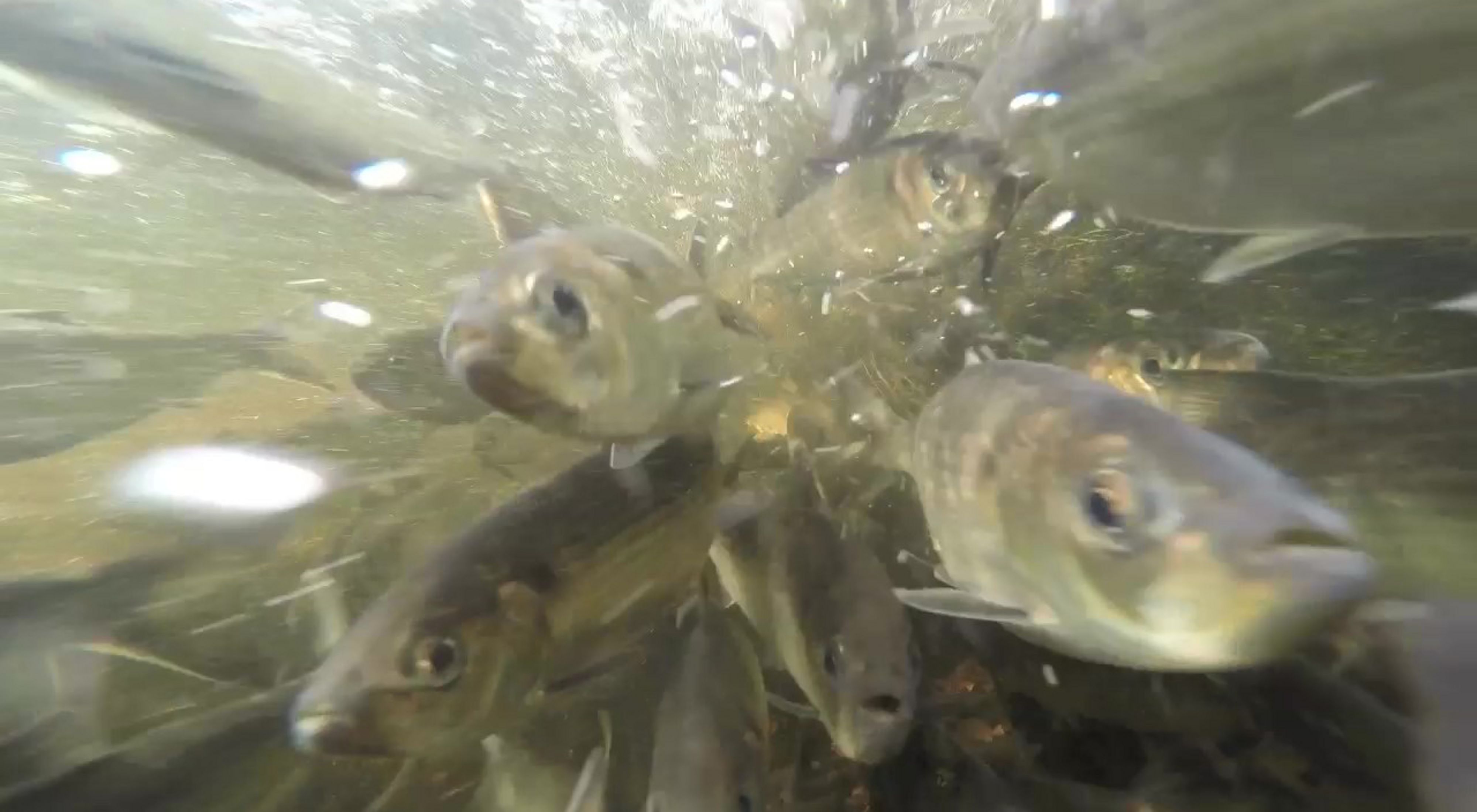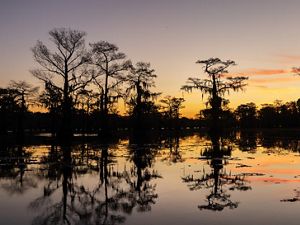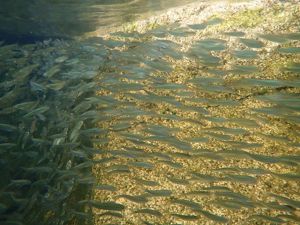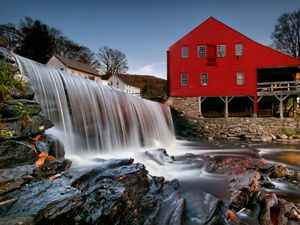Each year, more than 1,000 fish species around the world migrate to, from or within rivers to reproduce, escape predation or drought, find feeding grounds, seek warmer or cooler waters, or fulfill other critical life cycle needs. Healthy river and stream corridors are also essential for amphibians, reptiles and mammals, such as manatees and river porpoises. Some swim from larger rivers, lakes or headwaters, while others—like salmon, river herring and some trout—travel thousands of miles across oceans and bays to reach critical freshwater habitats. Sadly, their journeys are increasingly becoming more treacherous, or not possible at all.
World Fish Migration Day
May 25, 2024 will mark the 6th World Fish Migration Day (WFMD), a biennial event The Nature Conservancy helped found in 2014. WFMD is a global celebration to create awareness about the importance of migratory fish and free-flowing rivers. The WFMD website includes a list of scheduled events.
These aquatic species face obstacles of all sorts, such as dams, locks, levees and culverts, many of which are impassible. Sometimes the places they need to get to—floodplains, wetlands and side channels that offer life-stage-specific nutrition, protection from predators and ideal conditions for rearing young or laying eggs—have been destroyed or are severely degraded. We know that wetlands are disappearing at three times the rate of tropical forests, and, according to new research in Scientific Data, in just the last 30 years, we've lost nearly 232,000 square miles (600,000 square kilometers) of floodplains—an area the size of France or California.
And the same waters through which fish migrate or go to spawn are becoming increasingly polluted, or in some cases, drying up all together.
These are the primary reasons why freshwater species populations around the globe have declined an average of 81% since 1970—far more than declines seen in terrestrial or marine species.
Migratory Fish and Barriers by the Numbers
-

81%
Monitored populations of migratory freshwater fish have declined an average of 81% between 1970 and 2020.
-

1/3
Just one-third of the world's longest rivers remain free-flowing.
-

40%
River systems altered by dams and other barriers have led to 40% of America’s fish species being listed as imperiled and many commercial fisheries being decimated.
-
1M
Nearly 1 million dams, culverts and other barriers across the United States block fish from migrating upstream.
Such declines affect more than just fish and other wildlife. Migratory fish support commercial and recreational fishing industries that generate tens of billions in revenue each year. In Alaska’s Bristol Bay alone, the sustainable commercial harvest of wild salmon is valued at $2.2 billion annually and employs more than 10,000 people. In 2022, Bristol Bay experienced a record return of nearly 72 million sockeye salmon. This yearly migration makes for a rich ecosystem and remarkable way of life for people in Indigenous communities where the harvest of wild salmon is a cherished part of their culture.
How We Improve Freshwater Health & Connectivity
We Protect and Restore Freshwater Systems
Fresh water is connected to everything The Nature Conservancy does, and we’re determined to protect and restore freshwater ecosystems at unprecedented scales. By leveraging our long history of innovation and collaboration, we know we can scale up breakthrough strategies for fresh water that are durable and long-lasting. Our work in Ecuador serves as a prime example of ways in which we’re implementing long-term protection efforts to conserve freshwater systems above and below ground to keep them healthy and intact.
We’re already working on close to 400 projects in nearly 40 countries, but we must go further and faster to achieve our goals for 2030. (For a broader picture of our freshwater work around the globe, visit “Water Connects Us All” on nature.org.)
Protection and restoration can go hand-in-hand. TNC’s work to restore streams, rivers, wetlands and floodplains is a strategy we use to mitigate the impacts of man-made structures or development that affect the hydrology and health of freshwater systems and the wildlife and people that depend on them.
Many of these man-made structures, like ditches, levees or dikes, are designed to drain wetlands or straighten rivers by cutting them off from side channels or floodplains, which often provide some of the most important habitat for fish and a wide array of other species. These same structures can drastically impact the trees and plants in these places, which are adapted to periodic, natural fluctuations of high and low flows.
TNC has dozens of projects to improve the health of streams by restoring natural meanders and/or reconnecting them to side channels or other low-lying areas, and we and our partners have spearheaded some of the largest floodplain reconnection projects in the United States. Learn more.
We Overcome Barriers and Ensure Rivers Flow Freely
Only some one-third of the world’s largest rivers remain free flowing. Most have been severed by dams or other barriers. For example, in the United States, only some 2% of the nation’s 3 million miles of rivers and streams remain free-flowing and undeveloped, similar to other heavily developed nations. And countless other, smaller rivers and streams been altered by dams, locks, levees or culverts that impair or prevent the migration of aquatic species.
Overcoming Barriers
Below is a snapshot of how TNC addresses barriers that affect our freshwater systems. Click on each square to learn more.
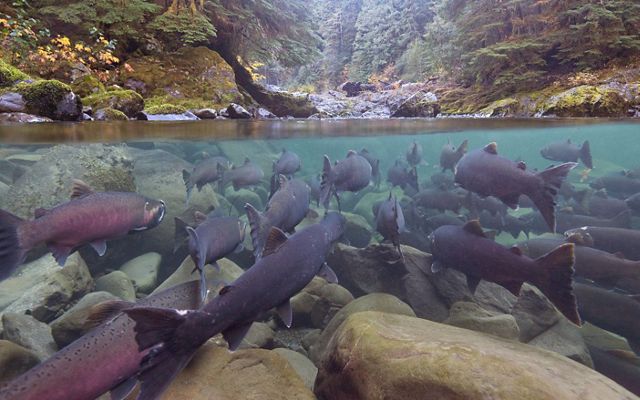
Groundwater Isn’t Just Underground
Did you know that groundwater provides about 30% of the nation’s surface streamflow, according to estimates from the U.S. Geological Survey? The rest is from rain and snowmelt. And some systems are completely driven by groundwater or completely dependent.
Select Freshwater Projects
Click on each square to learn more.
Partnerships & Funding that Improve Freshwater
As an environmental non-profit organization, the support of our donors enables TNC to leverage its science-based expertise and past work to influence and implement new projects that improve the health of freshwater systems around the globe. It’s important to note, however, that in the face of so much loss and degradation of habitat, partnerships—and the funding they can provide—are paramount in order to work at scale and achieve meaningful results.
In the U.S., critical partnerships and related funding include, but are not limited to:
- The National Oceanic and Atmospheric Administration (NOAA)
- The National Fish Passage Program
- The U.S. Fish and Wildlife Service
- The U.S. Forest Service
- The Natural Resources Conservation Service
- The Bureau of Indian Affairs
- Native American Fish and Wildlife Society
- The Federal Highways Administration
- The National Fish Habitat Partnership
- American Rivers
- The Atlantic Salmon Federation
- Trout Unlimited
- Numerous state fish and wildlife agencies
- Many local U.S. Tribes and Canadian First Nations
Internationally, critical partnerships include, but are not limited to:
- Dam Removal Europe
- World Wildlife Fund
- World Fish Migration Foundation
- Wetlands International
- Fauna and Flora International
- Conservation International
